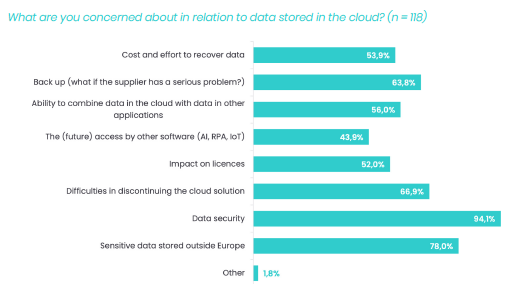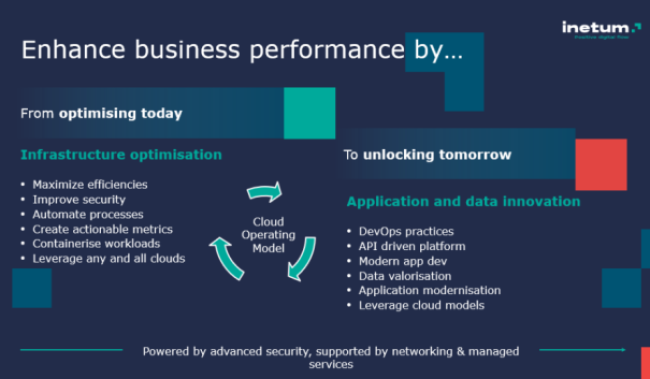Key advantages: flexibility and security
The good news is that the public cloud provides an answer to all these challenges. For example, the flexible cost structure allows you to do more effectively with the same or fewer resources. In the cloud, you only pay for the IT capacity you need now (opex). You no longer pay for an estimated IT capacity that you may need in the future (capex). Thanks to this flexible invoicing or financing model, you can spread your costs over time in a much more targeted way. At the same time, in the cloud it is easier to expand or scale down your IT capacity according to your needs.
That same flexibility, applied to technology, allows you to effectively move faster in the public cloud. After all, being able to work with off-the-shelf building blocks is a typical feature of cloud technology. That can allow you, for example, to put together a new solution that will quickly make new functionality available to the business. Thus, it fosters a competitive advantage that a traditional data center is not likely to offer, if only because you can't create additional IT capacity as quickly. In the traditional center, the lead time to deliver something new to the business—and thus also the time-to-market—is longer by definition.
Finally, all this out-of-the-box functionality also makes the staffing problem much less dire, as the cloud offers many built-in tools—for monitoring or patch management or infrastructure deployment, for example—that allow you to extensively automate your IT management. The right policies can also automatically ensure that the infrastructure stays in line with the business rules or compliance objectives that need to be met. As a result, not only will you be able to use your IT resources a lot more efficiently, but your IT staff will also be able to focus much more on their core tasks. Meanwhile, more time is freed up for IT tasks that provide greater added value for the business.
The cloud also has a lot to offer in terms of security, although there are unfortunately still much misunderstanding and preconception surrounding it. In the meantime, however, independent audits have more than convincingly shown that public cloud services offer a very high level of security. A provider such as Microsoft Azure also provides an extensive catalogue of useful security tools and services to ensure this, allowing you to apply all required security measures to the services you purchase from their public cloud.
Step 1: Analysis and assessment
Once you have been won over to the public cloud, the question of how best to make the move to that new IT environment arises. As with any IT project, good preparation is half the battle. So, everything starts with a planning phase. Starting from a concrete business question or need, you will define your goals in this crucial starting phase, possibly also defining KPIs or measurement points, and perhaps even develop an initial proof-of-concept, in order to develop a clear, achievable cloud strategy on the basis of all this.
Once this strategy has been properly established, it is also important to carry out a thorough analysis and assessment of your existing IT environment. For your convenience, Microsoft provides its own service for that: Solution Assessment. As a certified Azure partner, Inetum can offer that cloud service as well. Good to know: as part of such an assessment, we do much more than just inventory. We simultaneously seek to rationalize and optimize available IT resources as much as possible.
Finally, we draw on that objective inventory to help translate your cloud strategy into a concrete and practically implementable cloud plan. To be clear, companies often don't come knocking on our door until later in that planning phase, but even when creating a business case and developing a strategy for cloud adoption, our experts can already lend you a hand. The same applies to budgeting: you can always count on us for that part of the exercise, to reduce your licensing costs, for example.
Step 2: Design
Before you begin the actual cloud migration, you still need to shape and set up the foundations of that new environment. Migrating to Microsoft’s public cloud is largely about setting up an Azure Landing Zone: an environment predesigned according to a set of Microsoft best practices. Using such a landing zone ensures that your application workloads (e.g., websites, but also virtual machines) can land in the Azure platform on a standardized basis. Landing zones guarantee a repeatable and consistent approach to both construction and operational management of your IT assets in Azure.
The nature of the foundations you still need to shape in this design phase is quite diverse: from all sorts of security aspects, such as setting up rules for identity and access management, to choosing a network that can provide the connectivity you need. After all, moving the servers themselves is a straightforward process— the migration of everything attached to or running on these systems (applications, data, functionality, to name but a few)—that demands the most attention. We are happy to help you solve that connectivity and integration issue as well. The truth is, most organizations and their IT environments today are hybrid in nature, operating partly offline and partly online, partly locally and partly in the cloud. So it is important that they be capable of communicating with external applications and collaborating with third parties.
Step 3: Implementation
Once all these foundations are in place, you can proceed with the actual cloud migration. Even during that adoption phase, we don’t limit ourselves to the migration process alone. At the same time, we want to enable as much innovation as possible. With this goal in mind, we will also immediately formulate proposals for optimizing your cloud environment right away.
In doing so, it’s quite possible that some of those best practices will have already yielded quick gains in the previous, preliminary phase. These might include cloud solutions for backup, monitoring or patch management that help reduce operational costs or unburden your IT staff in their operational management.
Step 4: Commissioning and aftercare
In fact, with those managed services, we have already arrived at aftercare. We actually recommend that everyone combine the traditional IT environment maintenance with managed services that (further) automate the operational management of that environment. By taking as many repetitive operational tasks out of the hands of in-house IT professionals as possible and handing them over to a specialized IT partner like Inetum, much more time is freed up for strategic, business-critical IT projects.
So much for the four essential steps in our Inetum approach, which relies to a large extent on the Microsoft Cloud Adoption Framework for Azure.
Don’t forget the user, either
Characteristic of our approach is that it is an iterative learning process, where you continuously build on the lessons and experiences from previous project phases. So we’d like to close with two important additional tips from our experts who can help make a difference. First, don't forget to test enough, before, during and after the migration. Second, make sure you take as many as possible of the various users along on your journey to the cloud, as soon as possible in the process. Otherwise, that journey is doomed to fail in advance.
Want to learn more?
Are you planning a cloud migration? The Inetum and Microsoft joint service,Migration and Modernization Solution Assessment, you get a perfect picture of your current environment and data, derived from our sophisticated tools, and real-time data. Our assessment also provides you with a clear technical roadmap, including comprehensive business cases, to support your chosen cloud strategy for your IT infrastructure, data and applications. Click here for more info on our approach.
Are you interested? Would you like to know whether your organization qualifies for our free assessment? Do you have a question or comment for us? Then feel free to contact our experts at info@inetum-realdolmen.world without obligation.





